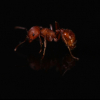Hi everyone!
Today, I caught a Pseudomyrmex gracilis queen as she was foraging. Right now she is in a standard test tube setup covered with foil to help her calm down.
I know this is a semi-claustral species, and I've got fruit flies that I can feed her, but I'm wondering about how to keep them. I know drew had issues keeping P. apache.
Any tips?
EDIT: After reading that they like DRY nests, I've moved her to a plain glass test tube.
Thanks!
-cpman
Edited by cpman, June 18 2015 - 11:30 AM.
















